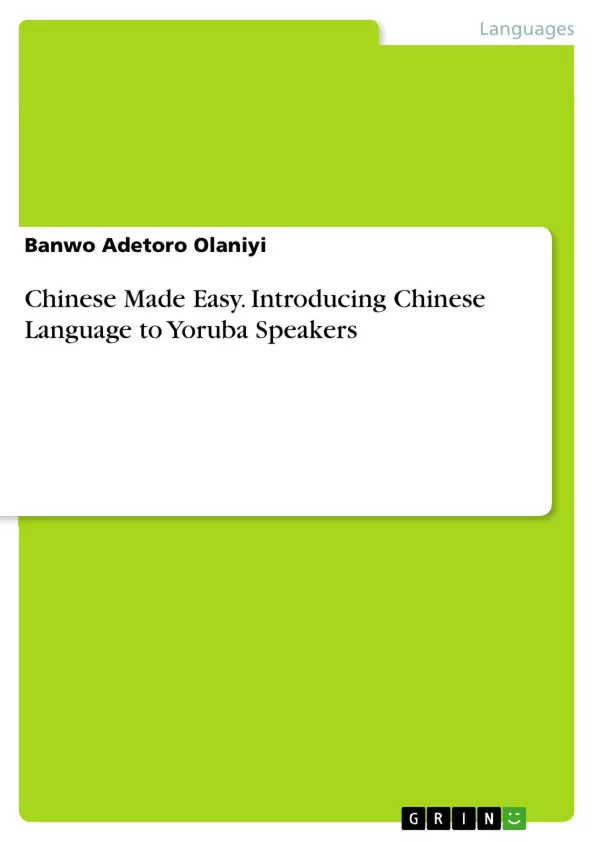Chinese Made Easy was a project inspired by the ‘Three Language Flavour Project’ of the Confucius Institute at the University of Lagos, Akoka, Lagos, Nigeria. The central aim of the project is to make Chinese easy for non-native speakers of the language and most especially to bring the language to them in their local language.
This work translates Chinese into English and then into Yoruba, it's the first of its kind in the history of Nigeria and Africa as a whole. For language to be easily disseminated it has to be absorbed in a form in which the learner can interpret and understand the contents of the language. This principle guided the development of the contents of this work.
While this work is useful for those who are keen on the Chinese language, this work also bridges the gap for Chinese citizens who seek to understand and have knowledge of the Yoruba language. It is a piece of works that would help younger learners and adults learn the Chinese language with ease.
Inhaltsverzeichnis (Table of Contents)
- Introduction
- Lesson 1: Introduction to Chinese...
- ÈKO KINNI: ÌFIHÀN SÍ ÈDÈ CHINESE...
- Lesson 2: Phonetics.......
- ÈKÒ KÈJÌ: FÓNÉTÍÌKÌ.
- Lesson 3 - Numerals & Birthdays.
- ÈKO KĘTA – ÒÙNKÀ & ODÚN
- Lesson 4 Surname, First Name
- ÈKÓ KÈRIN: ORÚKO ÌDÍLÉ, ORÚKO ÀKÓÓKÓ.….…………………………..
- Lesson 5 Country & Nationalities ......
- ÈKO-KARÙN:ORÍLÉ-ÈDÈ..
- Lesson 6: Year, Month, Date, Day.
- ÈKO-ÈFÀ: ODÚN, OSÙ, OSÈ, OJÓ
- Lesson 7: Time.
- EKO KEJE: ASIKO..
- Lesson 8: Public Places
- ÈKO KEJO: IBIGBANGBA
- Lesson 9: Daily Necessities.
- ÈKÓ KEWA: AWON OHUN ÈLÒ OJOJÚMÓ
- Lesson 10- Buying things & Prices
- ÈKÓ KEWA: RÍRA NNKAN, OWÓ ỌJÀ
- Lesson 11 Wines & Drinks
- ÈKÓ KEJILÁ- OTÍ,OTÍ ÈSO ÀJÀRÀ...
- Lesson 12: Food
- ÈKÓ KEJILÁ: ÓÚNJĘ
- Lesson 13-Family and Profession.........
- ÈKÓ KETALÁ: ÌDÌLÉ ATI ISÉ.
- Lesson 14: Languages and Learning
- ÈKÓ KERINLA: ÈDÈ, KÌKÓ .
Zielsetzung und Themenschwerpunkte (Objectives and Key Themes)
This book aims to introduce the Chinese language to Yoruba speakers, bridging the language barrier and cultural differences. It provides a comprehensive guide to basic Chinese grammar, vocabulary, and pronunciation, utilizing Yoruba translations and explanations to facilitate learning.
- Introducing Chinese language to Yoruba speakers
- Bridging the language barrier and cultural differences
- Facilitating easy understanding and use of Chinese through Yoruba translations
- Providing a comprehensive guide to basic Chinese grammar, vocabulary, and pronunciation
- Exploring the relationship between Chinese and Yoruba languages
Zusammenfassung der Kapitel (Chapter Summaries)
The book begins with an introduction to the Chinese language, exploring its history, importance, and relevance to Yoruba speakers. It then delves into the basics of Chinese phonetics, explaining pronunciation and tones. Subsequent chapters cover fundamental aspects such as numerals, birthdays, names, countries, nationalities, time, public places, daily necessities, buying and selling, wines and drinks, food, family, and professions. Each chapter provides a systematic approach to learning, incorporating Yoruba translations, examples, and exercises to reinforce understanding.
Schlüsselwörter (Keywords)
This book explores the Chinese language, Yoruba language, language learning, cultural exchange, language barrier, translation, phonetics, grammar, vocabulary, pronunciation, basic Chinese, Yoruba speakers, bilingualism, contrastive linguistics.
- Quote paper
- Banwo Adetoro Olaniyi (Author), 2016, Chinese Made Easy. Introducing Chinese Language to Yoruba Speakers, Munich, GRIN Verlag, https://www.grin.com/document/338907



